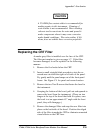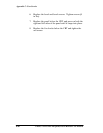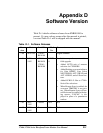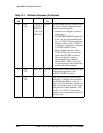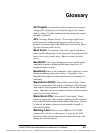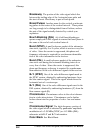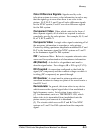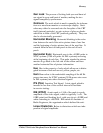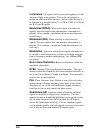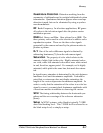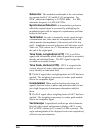
Glossary
1740A/1750A Series Waveform/Vector Monitor User Manual
G-3
Color Difference Signals Signals used by color
television systems to convey color information in such a way
that the signals go to zero when there is no color in the
picture. R--Y, B--Y, I, and Q are all color difference signals
for the NTSC system; U and V are color difference signals
for the PAL system.
Component Video Video which exists in the form of
three separate signals, all of which are required in order to
completely specify the color picture. For example, R, G, and
B; or Y, R--Y, and B--Y.
Composite Video A single video signal containing all of
the necessary information to reproduce a color picture.
Created by adding quadrature amplitude modulated R--Y and
B--Y to the luminance signal for NTSC systems or U and V
to the luminance signal for PAL systems.
CW Continuous Wave. Refers to a separate subcarrier sine
wave used for synchronization of chrominance information.
dB (Decibel) A decibel is a logarithmic unit used to
describe signal ratios. For voltages, dB = 20 Log
10
(V
1
/V
2
).
DC-Coupled A connection configured so that both the
signal (AC component) and the constant voltage on which it
is riding (DC component) are passed through.
DC Restorer A circuit used in picture monitors and
waveform monitors to clamp one point of the waveform to a
fixed DC level.
Demodulator In general, this term refers to any device
which recovers the original signal after it has modulated a
high--frequency carrier. In television it may refer to:
(1) An instrument, such as a TEKTRONIX 1450, which
takes video in its transmitted form (modulated onto the
picture carrier) and converts it to baseband.
(2) The circuits which recover R--Y and B--Y for NTSC
systems or U and V for PAL systems from the composite
signal.




